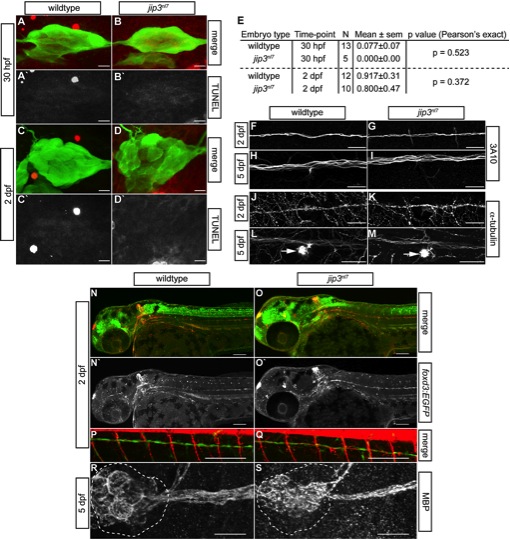Fig. S1 pLL nerve abnormalities in jip3nl7 were not due to cell death, general cytoskeletal defects or glial deficits. (A?D) Cell death in the pLL ganglion was examined by TUNEL assay at 30 hpf and 2 dpf. Confocal projections of the pLL ganglion showed that TUNEL labeling (red in merge, white in single channel) was not elevated in jip3nl7 during (30 hpf) or after (2 dpf) nerve extension. Expression of the neurod:EGFP transgene marks the pLL ganglion. (E) Quantification of TUNEL-positive cells in the pLL ganglia of wildtype and mutant embryos. (F?I) Immunolabeling with an antibody against a neurofilament associated antigen demonstrated no deficit in the pLL nerve of jip3nl7 at 2 and 5 dpf. (J?M) Similarly, analysis of microtubule density in the pLL nerve with an antibody against α-tubulin revealed no significant changes in the jip3nl7. Arrow indicates hair cell stereocilia which contain high levels of tubulin. The distal nerve at NM4 is shown for F?M. (N?Q) Glial cell occupation of the pLL nerve was analyzed using a combination of two transgenic lines, TgBAC(foxd3:EGFP)nl5 (glia) and TgBAC(neurog1:DsRed)nl6 (nerve). Just after nerve extension (2 dpf), glial occupation of the pLL nerve was normal in jip3nl7. The distal portion of the pLL nerve at NM4 is shown in P and Q. (R,S) Myelination of the pLL nerve was also normal at 5 dpf in jip3nl7 as assayed by antibodies against MBP (myelin basic protein). The pLL ganglion is outlined. Scale bars in A?D, F?M and R,S are 25 μm; N?Q are 100 μm.
Image
Figure Caption
Acknowledgments
This image is the copyrighted work of the attributed author or publisher, and
ZFIN has permission only to display this image to its users.
Additional permissions should be obtained from the applicable author or publisher of the image.
Full text @ PLoS Genet.

